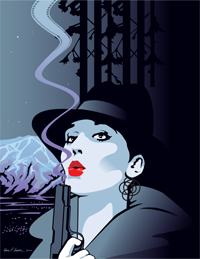Sun Valley is a little too pristine and pleasant to be the setting for film noir. The genre usually calls for a gritty city with seedy streets, dark alleys and cynical psyches. But filmgoer-friendly local residents and visitors will likely embrace a noir movie festival, said Hailey resident Jeannine Gregoire, founder of the inaugural Sun Valley Film Noir Series, which opens next week at the nexStage Theatre in Ketchum.
“You just can’t help but be pulled in by film noir,” Gregoire said. “It’s like reading a great mystery novel that you can’t put down.”
The event, themed “Dark Dreams,” will feature screenings of three noir classics — “Double Indemnity,” “Laura” and “Kiss Me Deadly” — on Thursdays from Sept. 11-25.
The movies were selected by Greg Olson, film director at the Seattle Art Museum, who founded the world’s oldest film noir festival 37 years ago, when cinema had yet to establish itself as an art form.
Olson’s expertise comes to Idaho via Wood River Valley native Gregoire, a media marketing expert who recently retired. She previously lived in Washington and attended the Seattle film noir series, where she met and became friends with Olson.
“He was my inspiration,” Gregoire said, to create a similar series when she returned to her hometown three years ago.
Film noir is associated with films of the 1940s and early ’50s, but no one in Hollywood called them by that name at the time.
Olson, also the author of a biography about director David Lynch, said the term “film noir,” meaning “black film” or “dark film,” was coined by French critics Raymond Borde and Etienne Chaumeton in their 1955 book “A Panorama of American Film Noir.”
“These French people somehow picked up on the artistry of what we would call mainstream American film,” Olson said. “They realized that all these films were dealing with the darker side of human nature, but specifically in the context of America: big business, government, police.”
The films also had a similar look, with high-contrast black-and-white, shadows and tilted film angles, “reinforcing that queasy feeling of discombobulation, confusion and anxiety,” Olson said.
These film techniques are familiar now, but in the 1940s, Olson said, they were “revolutionary.”
Film noir’s look was inspired by German-Austrian cinematic artists who fled to America before and during World War II, including Fritz Lang, Billy Wilder and Otto Preminger.
“They were steeped in the German aesthetics of shadows,” Olson said. “People in Hollywood realized, ‘This looks pretty cool.’”
The noir sensibility is also linked to hard-boiled detective writing of the era by authors like Dashiell Hammet.
Olson has a favorite one-sentence description of film noir: “The world is a dangerous place.”
“Any time in history it seems like the world is going to hell,” Olson said. “There’s lots of darkness in the world, and World War II underscored how barbaric people could be with the existential abyss and horror created by the atomic bomb.”
To choose the films for Sun Valley’s first venture into noir, Olson said he tried to place himself in the mind of “somebody who knew about film noir and loved it, and somebody who had no idea about what it was. I wanted to knock both their socks off.”
So Olson selected what he considers three quintessential noir films.
“Double Indemnity (1944), directed by Wilder, co-written by Raymond Chandler and starring Fred MacMurray and Barbara Stanwyck, is the tale of a murder insurance fraud scheme. Set in L.A., it was nominated for seven Oscars, including best picture.
“People think 1941’s ‘Maltese Falcon’ was the first film noir, but it’s really a typical detective movie,” Olson said. ‘“Double Indemnity’ has that dark perversity about it.”
The 1944 film “Laura,” produced by Preminger and starring Gene Tierney, Dana Andrews, Clifton Webb, Vincent Price and Judith Anderson, is about a New York police detective who falls in love with a woman whose murder he is investigating.
“It takes place in upper-crust New York, with a lot of literary folks who love to cut each other to ribbons at cocktail parties,” Olson said. “And you get the archetype of the burned-out police detective.”
“Kiss Me Deadly” (1955), directed by Robert Aldrich, stars Ralph Meeker as Mickey Spillane’s private investigator Mike Hammer, who investigates a murder after picking up a hitchhiker.
“This is another L.A. story, but more down and dirty,” Olson said. “Mike Hammer doesn’t have finesse: He’s right in your face.”
Olson said when Gregoire asked him to help curate a festival in Sun Valley, he teased her about the non-noir location.
“But although the cityscape at night is really part of noir, there are a few snow-country film noirs,” he said. “Usually it’s when a cop gets burnt out in the big city and moves away, but his dark past catches up with him.”
Sun Valley Film Noir Series
WHAT: The inaugural event, themed “Dark Dreams,” will feature screenings of three noir films.
WHEN: 7:30 p.m. Thursdays. “Double Indemnity,” Sept. 11; “Laura,” Sept. 18; and “Kiss Me Deadly,” Sept. 25. An opening reception at 6:30 p.m. Sept. 11 will feature a discussion with film noir experts.
WHERE: nexStage Theatre, 120 N. Main St., Ketchum.
COST: $10 per screening; tickets available at Iconoclast Books, Chapter One and Frenchman’s Gulch Winery in Ketchum; at Copy & Print in Hailey; and at the box office the night of each screening. Founder Jeannine Gregoire said any profits from the event will be donated to scholarships for local students.


 Idaho artist Ward Hooper created this poster image for the first-ever Sun Valley Film Noir Series, which begins Sept. 11 at the nexStage Theatre in Ketchum.
Courtesy image by Ward Hooper
Idaho artist Ward Hooper created this poster image for the first-ever Sun Valley Film Noir Series, which begins Sept. 11 at the nexStage Theatre in Ketchum.
Courtesy image by Ward Hooper



































